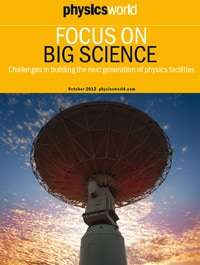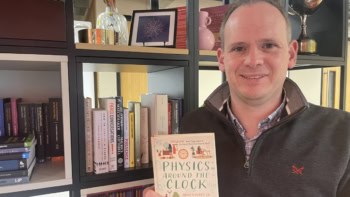By Michael Banks

Just a couple of weeks ago the European Commission kick-started the Extreme Light Infrastructure Nuclear Physics Facility (ELI-NP) project by announcing €180m towards its construction.
ELI-NP, costing €350m and to be built near Bucharest in Romania, will generate laser pulses with a power of some 10 petawatts (1016 W) – intense enough to study nuclear transitions in unprecedented detail.
The facility is one of four centres planned as part of the huge ELI project – the others being a centre in Hungary for attosecond physics, a third working on laser-based particle-beam production in the Czech Republic, and a fourth on ultrahigh-powered lasers. The latter’s location is still up for grabs.
Along with the ITER experimental fusion reactor in Cadarache, France, and the European Spallation Source in Lund, Sweden, ELI is just one of a whole host of “big science” facilities set to come online in the coming decade. Indeed, the Square Kilometre Array is now nearer to construction following a decision in May to split the facility between Australia and southern Africa.
It doesn’t stop there, with physicists looking even further ahead such as to a successor to CERN’s Large Hadron Collider, a muon collider, as well as an electron–ion collider that would be able to study gluons in unprecedented detail.
In a special focus issue accompanying the October edition of Physics World, and available to view free here, we take a look at the technical challenges in building and designing some of these big science facilities.
I hope you find this focus issue stimulating and please do let us have your comments by e-mailing pwld@iop.org.
Here’s a rundown of what’s inside:
• A phased approach – Jon Cartwright looks at the technology behind phased arrays – a key part of the planned Square Kilometre Array
• Planning the world’s next collider – An interview with linear collider director Lyn Evans on what comes next after CERN’s Large Hadron Collider
• The attraction of superconductors – Development of a magnet built from high-temperature superconductors will be at the heart of a proposed muon collider, as Tim Wogan reports
• Exploring “the mass that matters” – Peter Gwynne describes plans for an electron–ion collider – a new kind of facility that would study the properties of gluons
• New eyes for a dark world – Technology based on superconducting circuits will allow astronomers to detect every photon that arrives at a telescope’s lens, as David Appell explains
• Turkey accelerates ahead – Michael Banks travels to Ankara to hear plans for a Turkish Accelerator Centre
• Illuminating new frontiers – Brian Stephenson, director of Argonne National Laboratory’s Advanced Photon Source, gives his opinion on why the future is bright for light sources
Read the Focus on Big Science now



